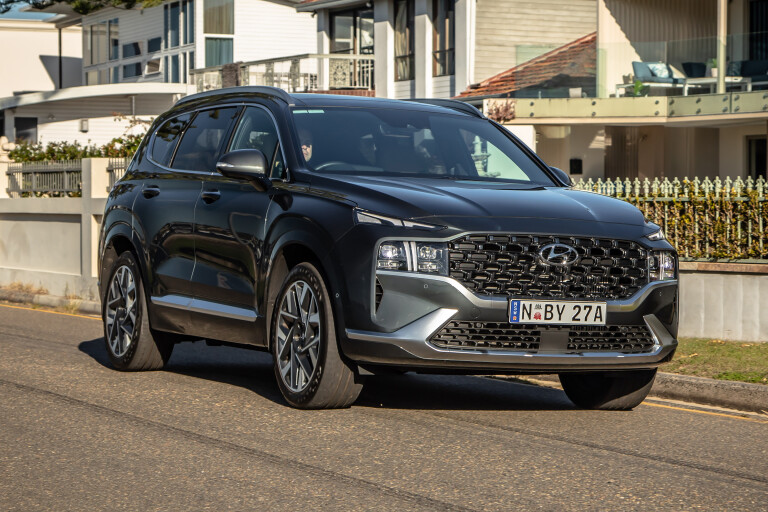
Score breakdown
Things we like
- Great new gearbox
- Loaded with tech and gear
- Much better than the petrol
Not so much
- No hybrid option
- No wireless CarPlay
- Tight third row
- Curtain airbags aren’t long enough
Life moves pretty fast in the large SUV market. Just a few weeks ago I was making fun of how old the Kluger was and then we had a whole new one land. With a hybrid driveline, no less. Kia’s new Sorento arrived in 2020 and the new Hyundai Santa Fe arrived in 2018.
Wait. A new Santa Fe arrived in 2021. Right? Well, yes, because it seemed that Hyundai were so keen to keep up that it gave its large SUV a hefty facelift inside and out to incorporate some new technology, new transmission for the diesel and up here in the Highlander, a whole new dash architecture.
So, as ever, Hyundai is not doing things by halves.
Pricing and Features

At $65,200 before on-road costs, the Highlander diesel clears the front-wheel drive petrol V6 by a stout $3500. You get 20-inch alloy wheels, a big 10.25-inch touchscreen, 12.3-inch digital dashboard, 10 speakers, sat nav, powered front seat adjustment (they're also heated and cooled), wireless phone charger, keyless entry and start, front and rear parking sensors, active cruise control, panoramic sunroof, auto LED headlights and auto wipers and a full-size spare.
For 2021, the Santa Fe picked up a number of safety upgrades. You get six airbags, ABS, stability and traction controls, forward AEB (10-65km/h for pedestrians and cyclists, 75km/h for cars), turn assist, rear cross traffic alert, rear AEB, lane keep assist and blind spot monitoring.

The fully digital dashboard includes Hyundai's blind spot vision tech. There are cameras on each side of the car that send a view of what is happening down the side of the car to match the direction of your indicators. It’s very useful and makes the digital dash worthwhile rather than just a reproduction of an analogue layout that can change colour.
You also get two sets of ISOFIX points and three top tether mounts in the middle row but none in the third. One of the upgrades it didn’t get was to ensure the curtain airbags reach all the way to the third row, so it’s probably just as well.
The five-star ANCAP rating carries over from the 2018 result.
Comfort and Space
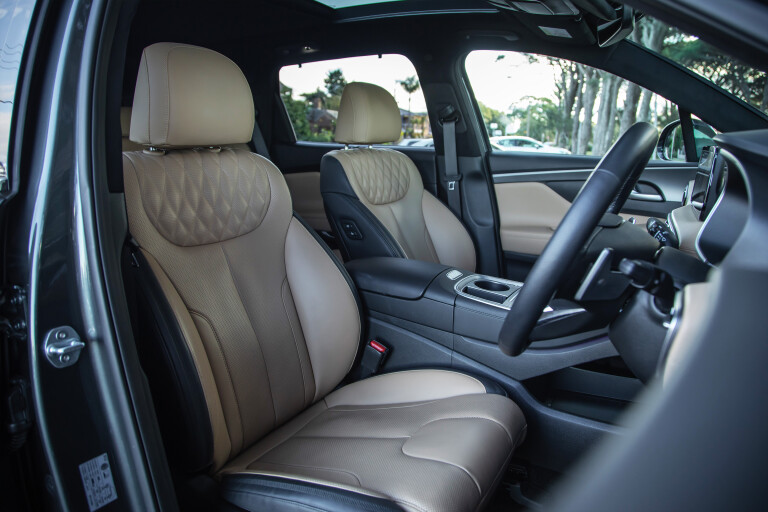
The Santa Fe is, obviously, gigantic although not as massive as its big brother, the Palisade. I deliberately mention the Palisade because the Highlander features its flying console layout.
Due to the push-button transmission selector requiring no mechanical connections into the engine bay, the space between the footwells has been opened up for a large tray into which you could put a small backpack or handbag.
Also up front are two cupholders, a console bin and two bottle holders in the doors. There is also a very clever slot into which you deposit your phone and if you put it in the right way, it’ll charge against the wireless charging pad. A little spring-loaded door holds it in place and for some reason, this makes me very happy.

The middle row is very useful in that it’s well-shaped and comfortable for outboard passengers and has tons of legroom. You can change the amount of legroom by sliding it back and forth in the 60:40 split sections and the backrests recline. The armrest has two cupholders and at the rear of the centre console are two USB ports. If that isn’t enough, the outboard seats are heated and the windows have roll-up sun shades.
To reach the third row you pull a latch that flips the middle row forward and slides. It’s not the most graceful access but I’ve seen much worse. Once in, it’s fairly tight for me at six foot tall but you can get reasonably comfortable if your hips flex and you don’t mind your knees in your face, so it’s fine for small kids.
The problem is the gap between booster seat-sized kid and uncomfortable kid is probably a bit short. It’s not really a lot more than an occasional use proposition. If you want a regular-use third row, wait for the Staria people mover, get a Palisade or defect to the Kia Carnival. If you are trapped back there, you get a further two cupholders and a slot to put some odds and ends.
The seats are covered in very nice Nappa leather, too, which makes them even more comfortable and nice to touch.
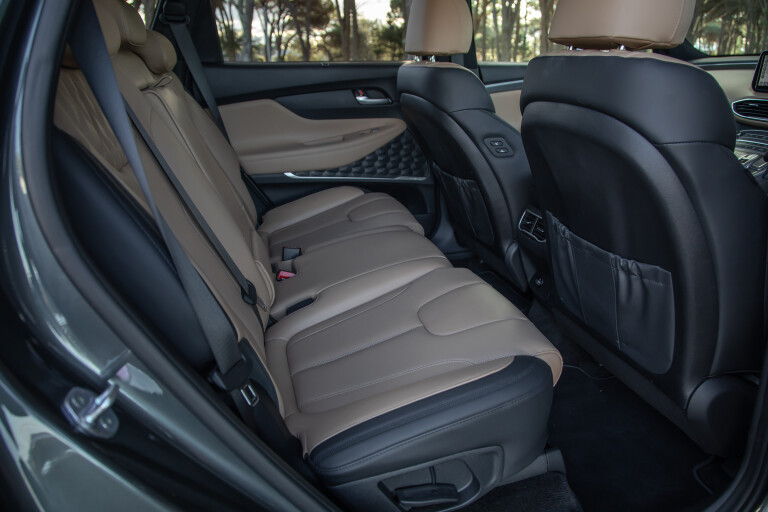
The boot starts at 130 litres with all seats in place. Push the third row down and you have between 571 and 782 litres. For some reason, Hyundai doesn’t give a figure for total capacity with the middle row folded down but I can tell you it’s a fantastically huge space with a flat floor.
The carpet that you can lay over the wagon portion of the boot is handy, stopping you from snagging things on the third-row seatbacks and the whole shebang is accessible via the powered tailgate.
Towing capacity is rated at 2500kg for a braked trailer, 750 unbraked and a maximum towball load of 200kg.
The Santa Fe is, obviously, gigantic although not as massive as its big brother, the Palisade.
On the Road
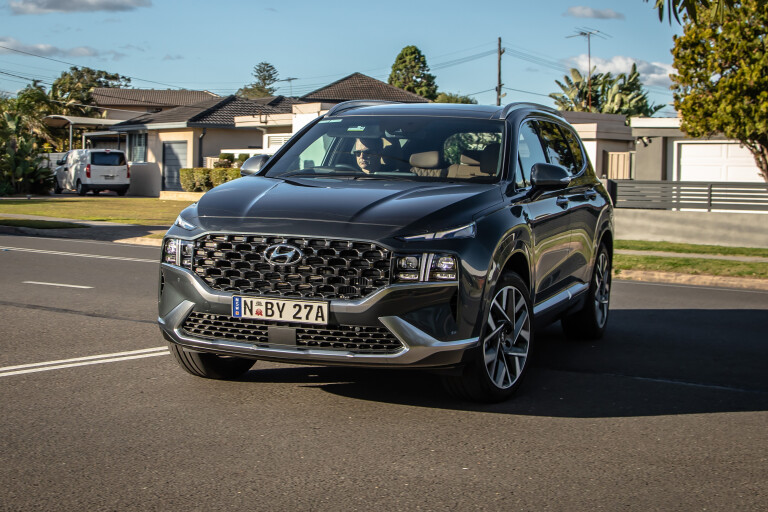
While the 2.2-litre diesel has been around forever, the new eight-speed dual-clutch transmission already seen on the Sorento is not. It’s an absolute belter of a gearbox with seemingly few of the traditional drawbacks of the genre.
I thought it was a bit weird that Hyundai committed to twin-clutch as the Europeans abandon it, but it seems like it was the right decision. It shifts quickly and positively and it’s almost impossible to pick it as a dual-clutch. That’s a pretty decent win.
The engine produces a modest 148kW at 3800rpm and a handy 440Nm in a narrow 1750 to 2570rpm band. That’s where the eight-speed is especially useful, keeping the engine in the torquey sweet spot, making it feel overqualified to shift nearly two tonnes of all-wheel drive SUV.
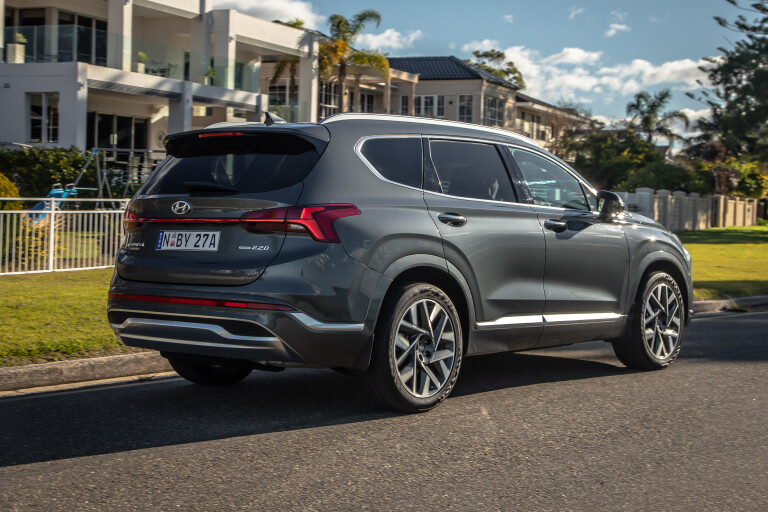
When this car first launched in 2018, I was a big fan of the handling. That made for good copy but it did sometimes render the ride a bit firmer than most customers were completely happy with. The new suspension tune is a global setup, while the previous car was signed off by the local team for Australian Santa Fes.
It’s a bit softer and more comfort-biased, which is probably for the best, and that local team naturally still had a good hand in it. The 2021 car rides the bumps as well as before but with less vertical movement. There is a little more body roll than before, but it still grips and the steering is still very well-judged for the type of car it is. So yeah, I’m still a fan.
It’s very quiet out on the motorway and was the perfect companion for a run up my usual route loop to the Blue Mountains. It climbed the hills without drama or hunting through the gears and even the garbage surface on the westernmost end of the M4 didn’t produce the usual roaring from the tyres. Well, it probably did, but it didn’t get into the cabin.
There is a little more body roll than before, but it still grips and the steering is still very well-judged for the type of car it is. So yeah, I’m still a fan.
Ownership
Hyundai's pace-setting five-year/unlimited-kilometre warranty does fall short of compatriot Kia’s seven years, but it’s still good going. Maintenance costs no more than $459 per service for the first five years and you have to return to the dealer every 12 months or 15,000km.
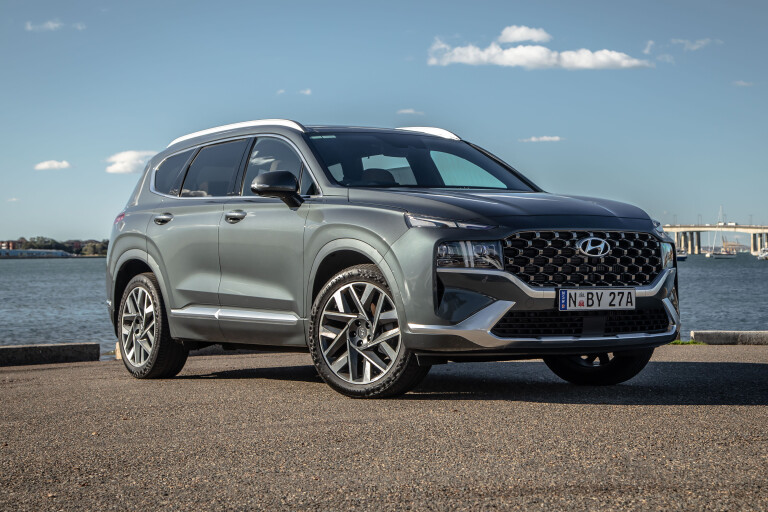
VERDICT
It seems weird to think a car needed a facelift so soon, but as the Santa Fe launched out of sync with everyone else, it probably had to happen.
A lot of good stuff has made its way into the Highlander and despite the extra price, the diesel is the one to have as you get all-wheel drive, a more relaxed drive and torque to haul your brood and their stuff to where you want to go.
The new cabin tech is great, the facelift looks suitably aggressive and it’s here to take the fight to the new Kluger while snapping at the heels of the Europeans with equivalent tech but better pricing. The only big downside is that you can’t get yourself a hybrid.
2021 Hyundai Santa Fe Highlander specifications
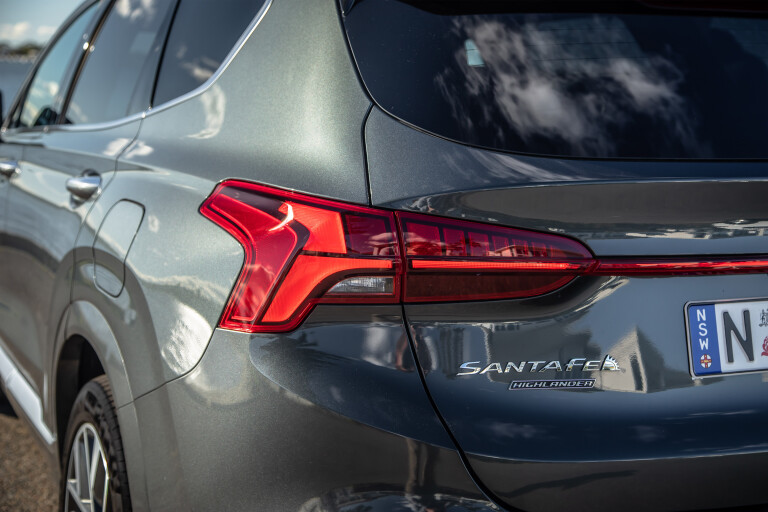
| Body | five-door large SUV |
| Drive | AWD |
| Engine | 2.2-litre four-cylinder turbodiesel |
| Transmission | eight-speed dual-clutch |
| Power | 148kW @ 3800rpm |
| Torque | 440Nm @ 1750-2750rpm |
| Bore stroke | 83mm x 99.4mm |
| Compression ratio | 16.0:1 |
| 0-100km/h | 9.3 sec (estimate) |
| Fuel consumption | 6.1L/100km (combined) |
| Weight | 1943kg |
| Suspension | McPherson struts (front); multi-link (rear) |
| L/W/H | 4785/1900/1710mm |
| Wheelbase | 2765mm |
| Brakes | 325mm ventilated disc (front); 305mm solid disc (rear) |
| Tyres | 255/45 R20 |
| Wheels | 20-inch alloy wheels (full-size alloy spare) |
| Price | $65,200 + ORC |
Score breakdown
Things we like
- Great new gearbox
- Loaded with tech and gear
- Much better than the petrol
Not so much
- No hybrid option
- No wireless CarPlay
- Tight third row
- Curtain airbags aren’t long enough



COMMENTS